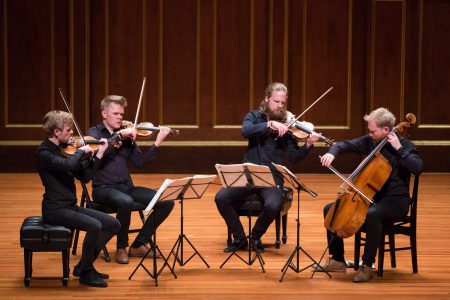Beethoven and Schnittke in Boston with the Danish String Quartet
|
Grant Chu Covell [January 2017.]
The Danish String Quartet presented by the Celebrity Series of Boston Saturday night at NEC’s Jordan Hall. (Photo credit Robert Torres.) Ludwig van BEETHOVEN: String Quartet in C minor, Op. 18, No. 4 (1798-1800). Alfred SCHNITTKE: String Quartet No. 3 (1983). BEETHOVEN: String Quartet in B-flat major, Op. 130 (1825), with Große Fuge, Op. 133 (1825). Danish String Quartet: Frederik Øland, Rune Tonsgaard Sørensen (vln), Asbjørn Nørgaard (vla), Fredrik Schøyen Sjölin (vlc) (http://www.danishquartet.com/). Saturday, January 28, 2017, 8:00pm, New England Conservatory Jordan Hall, Boston. This performance was presented by Celebrity Series of Boston (http://www.celebrityseries.org/). At Jordan Hall in Boston this past Saturday, the Danish String Quartet offered spotless performances of two Beethoven quartets. There’s not much that can stand up to Beethoven, but the group made a persuasive and unflustered case for Schnittke. In introductory remarks before their performance of Schnittke’s Third, the quartet’s violist, Asbjørn Nørgaard, reminded us that some artists use music to chronicle personal struggles. The ensemble then demonstrated two themes which pervade No. 3, quotations from Orlando de Lassus (Stabat Mater) and Ludwig van Beethoven (Große Fuge), and Nørgaard commented that the composers found solace in religion or its absence. These remarks provided a useful context for Schnittke’s baffling three-movement quartet. Nørgaard offered “polystylist” as a description of Schnittke’s compositional technique, which the folks sitting behind me misheard as “Polish-style.” I am sure Schnittke (and even perhaps Górecki) would have appreciated that malapropism. Schnittke’s Third was written in 1983, prior to the Fourth Symphony (1984), his first stroke (1985) and his move to Germany (1989). Besides the de Lassus and Beethoven, other ciphers (D-S-C-H, et al.) and motives appear. Fleeting passages imitate Shostakovich or Webern, while other moments could be lifted from any number of aleatoric or serialist composers. It is hard to say that material is actually developed, except by repetition or combination with other dissimilar content. Schnittke calls upon his experience as a film scorer to quickly vary moods and thwart expectations. I suspect Schnittke enjoyed spoofing styles which the Soviet system would have explicitly wanted him to ignore. The quartet provides no easy answers, except perhaps to suggest that we can’t have nice things. The Danish String Quartet plays with a remarkably focused sound, uniformly blended with consistent articulation. There were non-vibrato lines in the Schnittke that emerged with razor-sharp distinction. Watching the group, it appeared as if both violinists and the violist have intentionally cultivated consistent bow technique. Their demeanor suggests a comfort with music and performing rarely encountered in an ensemble that seems so young, except that three of them have been playing together since before they were teens, according to their similarly informal but direct website. Schnittke’s Third was sandwiched between two Beethoven quartets, Op. 18, No. 4 (not No. 2 as indicated in the advance notices), and Op. 130 which the Danish String Quartet offered with the original Große Fuge, Op. 133, final movement. The violinists alternated parts after the intermission which followed the Schnittke. Op. 18, No. 4 is an early work, however; in the Op. 18 set of six, Beethoven was showing his mastery of a form perfected by Haydn. In its first movement, the C-minor quartet plays with cadential tonic and dominant chords, momentarily taking away their harmonic function and making them thematic. Likewise in the strange scherzo (Agitato) at the middle of Schnittke’s quartet, decorative tonic and dominant chords conclude a Mendelssohnian (or Wagnerian) sequence which repeats comically as it transposes upwards. I was glad they took the first movement repeat in Op. 18, No. 4. Beethoven’s Op. 130 is six movements. No longer abiding the traditional four-movement Classical form, Beethoven follows a big rambling first movement with a sequence of smaller movements, including a miniature red-hot Presto and a Schubertian Ländlerische “Alla danza Tedesca.” The fifth movement, Cavatina, is of sumptuous beauty looking ahead to Mahler. We were ready for Beethoven’s original finale, the quarter-hour Große Fuge, whose theme had already been introduced in the Schnittke. Beethoven received reports that the original fugal ending was met with incomprehension. As fugues go, it is thick and dense, arguably constipated as Beethoven never quite achieves the elegance that Bach might have given the complex harmonic and rhythmic ingredients. It is a wild ride that nonetheless commands veneration and the Danish String Quartet delivered an exemplary performance. Beethoven’s brusque tempo changes and varied mood swings seemed quite normal after the Schnittke. Perhaps this was the Quartet’s intention, to suggest that Schnittke used Op. 130 (or even Op. 131) as a template, and that Beethoven originated juxtapositions and the quicksilver changes in style we associate with modernism or polystylism. The Danish String Quartet appears not to give in to histrionics. There were moments in the Schnittke and the Große Fuge where other groups would have wandered off the rails under the guise of expression, but not these four. They play with bold delicacy, as if there is a firm line of cultivation that they will not cross. You could bring out your best porcelain tea set for this quartet and be assured that they will treat it with care and respect. However, you may catch them passing a flask of something stronger amongst themselves.
[More Grant Chu Covell, String Quartets]
[Previous Article:
Love and Lust, Near and Far]
[Next Article:
Pièces de Clavecin 9: Older and Newer Rameau]
|
